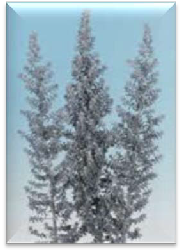Also Known as: Mexican fireweed, burning bush, summer cypress, mock cypress
Kochia (Kochia scoparia L.), native to Eurasia, is an annual plant that reproduces from seeds. It has a deep taproot and network of fibrous roots. Mature plants typically range from one to four feet tall, but can grow several feet taller. Kochia is bushy with multiple branches of finely textured linear foliage that turns red in the fall. The leaves are alternate, simple, stalkless, 1 to 2 inches long, and fringed with hair. Flowering occurs July to October. The flowers are small, green and inconspicuous and are found in clusters in the axils of upper leaves and in short, dense spikes. Seeds are short-lived, brown, flattened, about 1/16 inch long, and grooved on each side. A single plant produces an average of nearly 15,000 seeds, which can be dispersed when the mature plant breaks off and becomes a tumbleweed. The plant is drought- tolerant, enhancing its ability to spread.
Control Methods
Because most kochia seeds do not live more than a year, preventing seed production for a single year will significantly reduce the following year’s infestation. Since germination occurs early in the season, control methods are most effective in early spring. As long as plants have not yet set seed, mowing, cultivation and herbicides can effectively control kochia.
Chemical: Kochia can be effectively controlled with a variety of herbicides. Unfortunately, herbicide resistance in kochia is becoming a greater problem. In Idaho, Oregon and Washington, some kochia is resistant to chlorsulfuron (Glean®, Telar®), as well as other chemicals. Resistance can be deferred by rotating herbicides with different modes of action. It is important that the same Group of herbicides is not used more often than one in three years on the same field. There are a number of broadleaf herbicides from different Groups that can be used for kochia control. For best results, use proper herbicide rates and spray volumes with good coverage when plants are small. Because kochia emerges early in the spring, it is usually well advanced by the time other broadleaf weeds are ready to spray.
More information can be found in the PNW Weed Management Handbook
Use pesticides with care. Apply them only to plants, animals, or sites listed on the label. When mixing and applying pesticides, follow all label precautions to protect yourself and others around you. It is a violation of the law to disregard label directions. Store pesticides in their original containers and keep them out of the reach of children, pets, and livestock.
Biological: No insect biological agents are currently available for kochia control. Livestock readily graze kochia, although the plant sometimes contains high nitrate levels and can be toxic if consumed in large quantities.
Questions: contact Steve Van Vleet or phone (509) 397 – 6290
Photo credits included in PDF




